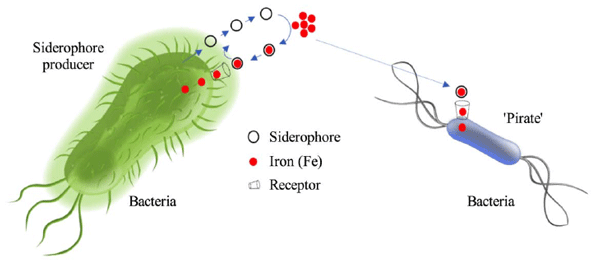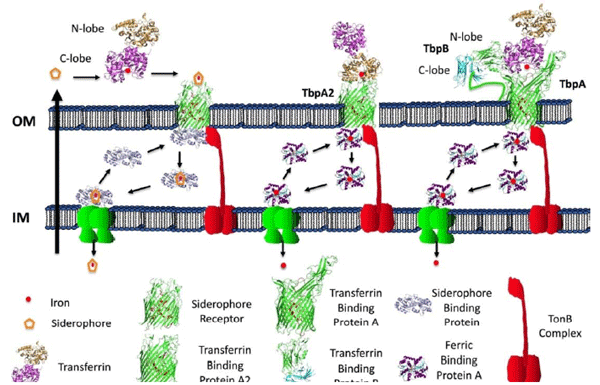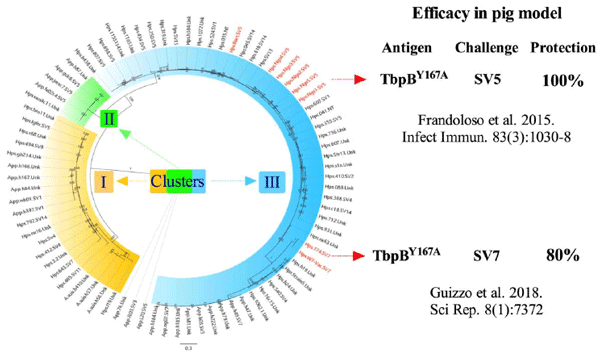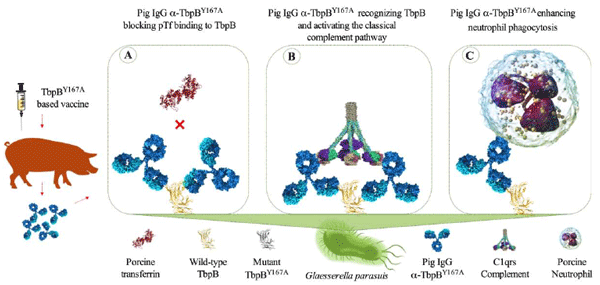Structure-based antigen design: Targeting transferrin receptors to prevent respiratory and systemic disease of swine





References
Ajito T, Haga Y, Homma S, Goryo M, Okada K. Immunohistological evaluation on respiratory lesions of pigs intranasally inoculated with Actinobacillus pleuropneumoniae serotype 1. The Journal of Veterinary Medical Science, 58, 297-303, 1996.
Anderson JE, Hobbs MM, Biswas GD, Sparling PF. Opposing selective forces for expression of the gonococcal lactoferrin receptor. Molecular Microbiology, 48, 1325-1337, 2003.
Bagg A, Neilands JB. Molecular mechanims of regulation of siderophore-mediated iron assimilation. Microbiological Reviews, 51, 509-518, 1987.
Baltes N, Hennig-Pauka I, Gerlach GF. Both transferrin binding proteins are virulence factors in Actinobacillus pleuropneumoniae serotype 7 infection. FEMS Microbiology Letters, 209, 283-287, 2002.
Barasuol BM, Guizzo JA, Fegan JE, Martinez-Martinez S, Rodriguez-Ferri EF, Gutierrez-Martin CB, Kreutz LC, Schryvers AB, Frandoloso R. New insights about functional and cross-reactive properties of antibodies generated against recombinant TbpBs of Haemophilus parasuis. Scientific Reports, 7, 10377,, 2017.
Barber MF, Elde NC. Nutritional immunity. Escape from bacterial iron piracy through rapid evolution of transferrin. Science 346, 1362-1366, , 2014.
Bello-Orti B, Costa-Hurtado M, Martinez-Moliner V, Segales J, Aragon V.Time course Haemophilus parasuis infection reveals pathological differences between virulent and non-virulent strains in the respiratory tract. Veterinary Microbiology, 170, 430-437, 2014.
Bertram TA. Quantitative morphology of peracute pulmonary lesions in swine induced by Haemophilus pleuropneumoniae. Veterinary Pathology, 22, 598-609, 1985.
Bosse JT, Janson H, Sheehan BJ, Beddek AJ, Rycroft AN, Kroll JS, Langford PR. Actinobacillus pleuropneumoniae: pathobiology and pathogenesis of infection. Microbes and Infection, 4, 225-235, 2002.
Bosse JT, Li Y, Fernandez Crespo R, Lacouture S, Gottschalk M, Sarkozi R, Fodor L, Casas Amoribieta M, Angen O, Nedbalcova K, Holden MTG, Maskell DJ, Tucker AW, Wren BW, Rycroft AN, Langford PR, Consortium BRT. Comparative sequence analysis of the capsular polysaccharide loci of Actinobacillus pleuropneumoniae serovars 1-18, and development of two multiplex PCRs for comprehensive capsule typing. Veterinary Microbiology, 220, 83-89, 2018.
Bosse JT, Nash JH, Simon Kroll J, Langford PR. Harnessing natural transformation in Actinobacillus pleuropneumoniae: a simple method for allelic replacements. FEMS Microbiology Letters, 233, 277-281,2004.
Bouchet B, Vanier G, Jacques M, Auger E, Gottschalk M. Studies on the interactions of Haemophilus parasuis with porcine epithelial tracheal cells: limited role of LOS in apoptosis and pro-inflammatory cytokine release. Microbial Pathogenesis, 46, 108-113, 2009.
Bujold AR, MacInnes JI. Attachment of Actinobacillus suis H91-0380 and Its Isogenic Adhesin Mutants to Extracellular Matrix Components of the Tonsils of the Soft Palate of Swine. Infection and Immunity, 84, 2944-2952, 2016.
Calmettes C, Alcantara J, Yu R.-H, Schryvers A.B, Moraes TF. The structural basis of transferrin sequestration by transferrin binding protein B. Nature Structural & Molecular Biology, 19, 358-360, 2012.
Cerda-Cuellar M, Aragon V. Serum-resistance in Haemophilus parasuis is associated with systemic disease in swine. Veterinary Journal, 175, 384-389, 2008.
Cerda-Cuellar M, Naranjo JF, Verge A, Nofrarias M, Cortey M, Olvera A, Segales J, Aragon V. Sow vaccination modulates the colonization of piglets by Haemophilus parasuis. Veterinary Microbiology, 145, 315-320, 2010.
Chiers K, Donne E, Van Overbeke I, Ducatelle R, Haesebrouck F. Evaluation of serology, bacteriological isolation and polymerase chain reaction for the detection of pigs carrying Actinobacillus pleuropneumoniae in the upper respiratory tract after experimental infection. Veterinary Microbiology, 88, 385-392, 2002.
Choi YK, Goyal SM, Joo HS. Retrospective analysis of etiologic agents associated with respiratory diseases in pigs. Canadian Veterinary Journal, 44, 735-737, 2003.
Clemence MEA, Maiden MCJ, Harrison OB. Characterization of capsule genes in non-pathogenic Neisseria species. Microbial Genomics, 4, 2018.
Cornelissen CN, Kelley M, Hobbs MM, Anderson JE, Cannon JG, Cohen MS, Sparling PF. The transferrin receptor expressed by gonococcal strain FA1090 is required for the experimental infection of human male volunteers. Molecular Microbiology, 27, 611-616, 1998.
Costa-Hurtado M, Barba-Vidal E, Maldonado J, Aragon, V. Update on Glasser's disease: How to control the disease under restrictive use of antimicrobials. Veterinary Microbiology, 242, 108595, 2020.
Costa-Hurtado M, Olvera A, Martinez-Moliner V, Galofre-Mila N, Martinez P, Dominguez J, Aragon V. Changes in macrophage phenotype after infection of pigs with Haemophilus parasuis strains with different levels of virulence. Infection and Immunity 81, 2327-2333, 2013.
Croucher NJ, Harris SR, Fraser C, Quail MA, Burton J, van der Linden M, McGee L, von Gottberg A, Song JH, Ko KS, Pichon B, Baker S, Parry CM, Lambertsen LM, Shahinas D, Pillai DR, Mitchell TJ, Dougan G, Tomasz A, Klugman KP, Parkhill J, Hanage WP, Bentley SD. Rapid pneumococcal evolution in response to clinical interventions. Science, 331, 430-434, 2011.
Curran D, Adamiak P, Fegan J, Qian C, Yu R, Schryvers AB. Sequence and structural diversity of transferrin receptors in Gram-negative porcine pathogens. Vaccine, 33, 5700-5707, 2015.
D'Onofrio A, Crawford JM, Stewart EJ, Witt K, Gavrish E, Epstein S, Clardy J, Lewis K. Siderophores from neighboring organisms promote the growth of uncultured bacteria. Chemistry & Biology 17, 254-264, 2010.
Dazzi CC, Guizzo JA, Prigol SR, Kreutz LC, Driemeier D, Chaudhuri S, Schryvers AB, Frandoloso R New Pathological Lesions Developed in Pigs by a “Non-virulent” Strain of Glaesserella parasuis. Frontiers in Veterinary Science, 7, 2020.
Dee S, Guzman JE, Hanson D, Garbes N, Morrison R, Amodie D, Galina Pantoja L. A randomized controlled trial to evaluate performance of pigs raised in antibiotic-free or conventional production systems following challenge with porcine reproductive and respiratory syndrome virus. PLoS One, 13, e0208430, 2018.
Dickerman A, Bandara AB, Inzana TJ. Phylogenomic analysis of Haemophilus parasuis and proposed reclassification to Glaesserella parasuis, gen. nov., comb. nov. International Journalof Systematic and Evolutionary Microbiology, 70, 180-186, 2020.
Donkó T, Kovács M, Magyar T. Association of growth performance with atrophic rhinitis and pneumonia detected at slaughter in a conventional pig herd in Hungary. Acta Veterinaria Hungarica, 53, 287, 2005.
Ekins A, Niven DF. Identification of fur and fldA Homologs and a Pasteurella multocida tbpA Homolog in Histophilus ovis and Effects of Iron Availability on Their Transcription. Journal of Bacteriology, 184, 2539-2542, 2002.
Espindola JP, Balbinltt N, Gressler LT, Machado G, Klein CS, Rebelatto R, Gutierrez-Martin CB, Kreutz LC, Schryvers AB, Frandoloso R. Molecular serotyping of clinical strains of Haemophilus (Glaesserella) parasuis brings new insights regarding Glasser’s disease outbreaks in Brazil. PeerJ, e6817, 2019.
Fegan JE, Calmettes C, Islam EA, Ahn SK, Chaudhuri S, Yu RH, Gray-Owen SD, Moraes TF, Schryvers AB. Utility of Hybrid Transferrin Binding Protein Antigens for Protection Against Pathogenic Neisseria Species. Frontiers in Immunology, 10, 247, 2019.
Foged NT, Pedersen KB, Elling F. Characterization and biological effects of the Pasteurella multocida toxin. FEMS Microbiology Letters, 43, 45-51, 1987.
Fraile L, Alegre A, Lopez-Jimenez R, Nofrarias M, Segales J. Risk factors associated with pleuritis and cranioventral pulmonary consolidation in slaughter-aged pigs. Veterinary Journal, 184, 326-333, 2010.
Frandoloso R, Martinez-Martinez S, Calmettes C, Fegan J, Costa E, Curran D, Yu RH, Gutierrez-Martin CB, Rodriguez-Ferri EF, Moraes TF, Schryvers AB. Nonbinding site-directed mutants of transferrin binding protein B exhibit enhanced immunogenicity and protective capabilities. Infection and Immunity, 83, 1030-1038, 2015.
Frandoloso R, Martínez-Martínez S, Yubero S, Rodríguez-Ferri EF, Gutiérrez-Martín CB. New insights in cellular immune response in colostrum-deprived pigs after immunization with subunit and commercial vaccines against Glässer’s disease. Cellular Immunology, 277, 74-82, 2012.
Frandoloso R, Pivato M, Martinez-Martinez S, Rodriguez-Ferri EF, Kreutz LC, Martin CB. Differences in Haemophilus parasuis adherence to and invasion of AOC-45 porcine aorta endothelial cells. BMC Veterinary Research, 9, 207, 2013.
Frey J. Virulence in Actinobacillus pleuropneumoniae and RTX toxins. Trends in Microbiology, 3, 257-261, 1995. Gonzalez GC, Caamano DL, Schryvers AB. Identification and characterization of a porcine-specific transferrin receptor in Actinobacillus pleuropneumoniae. Molecular Microbiology, 4, 1173-1179, 1990.
Gray-Owen SD, Schryvers AB. The interaction of primate transferrins with receptors on bacteria pathogenic to humans. Microbial Pathogenesis, 14, 389-398, 1993.
Guizzo JA, Chaudhuri S, Prigol SR, Yu RH, Dazzi CC, Balbinott N, Frandoloso GP, Kreutz LC, Frandoloso R, Schryvers AB. The amino acid selected for generating mutant TbpB antigens defective in binding transferrin can compromise the in vivo protective capacity. Scientific Reports 8, 7372, 2018.
Hansen MS, Pors SE, Jensen HE, Bille-Hansen V, Bisgaard M, Flachs EM, Nielsen OL. An investigation of the pathology and pathogens associated with porcine respiratory disease complex in Denmark. Journalof Comparative Pathology, 143, 120-131, 2010.
Heath PT. Haemophilus influenzae type b conjugate vaccines: a review of efficacy data. Pediatric Infectious Disease Journal, 17, S117-122, 1998.
Hunneman WA. Incidence, economic effects, and control of Haemophilus pleuropneumoniae infections in pigs. Veterinary Quarterly, 8, 83-87, 1986.
Jager HC, McKinley TJ, Wood JL, Pearce GP, Williamson S, Strugnell B, Done S, Habernoll H, Palzer A, Tucker AW. Factors associated with pleurisy in pigs: a case-control analysis of slaughter pig data for England and Wales. PLoS One 7, e29655, 2012.
Jong MF. Progressive and nonprogressive atrophic rhinitis. In:Straw, B.E. Diseases of swine, 9th ed. Blackwell Pub., Ames, Iowa, 2006.
Kadner RJ, McElhaney G. Outer membrane-dependent transport systems in Escherichia coli: Turnover of TonB function. Journal of Bacteriology, 134(3), 1020-1029, 1978.
Kellner J, Scheifele D, Vanderkooi O, MacDonald J, Church D. Effects of Routine Infant Vaccination with the 7-valent Pneumococcal Conjugate Vaccine on Nasopharyngeal Colonization with Streptococcus pneumoniae in Children in Calgary, Canada. Pediatric Infectious Disease Journal, 27, 526-532,2008.
Kernaghan S, Bujold AR, MacInnes JI. The microbiome of the soft palate of swine. Animal Health Research Review13, 110-120, 2012.
Kielstein P, Rapp-Gabrielson VJ. Designation of 15 serovars of Haemophilus parasuis on the basis of immunodiffusion using heat-stable antigen extracts. Journal of Clinical Microbiology, 30, 862-865, 1992.
Kramer J, Ozkaya O, Kummerli R. Bacterial siderophores in community and host interactions. Nature Reviews Microbiology, 18, 152-163, 2019.
Krejci J, Nechvatalova K, Kudlackova H, Faldyna M, Kucerova Z, Toman M. Systemic and local antibody responses after experimental infection with Actinobacillus pleuropneumoniae in piglets with passive or active immunity. Journal of Veterinary Medicine B., Infectious Diseases Veterinary Public Health, 52, 190-196, 2005.
Li J, Yuan X, Xu L, Kang L, Jiang J, Wang Y. Efficient construction of Haemophilus parasuis mutants based on natural transformation. Canadian Journal of Veterinary Research, 80, 281-286, 2016.
Lissolo L, Maitre-Wilmotte G, Dumas P, Mignon M, Danve B, Quentin-Millet MJ. Evaluation of transferrinbinding protein 2 within the transferrin- binding protein complex as a potential antigen for future meningococcal vaccines. Infection and Immunity, 63, 884-890, 1995.
MacInnes JI, Desrosiers R. Agents of the "suis-ide diseases" of swine: Actinobacillus suis, Haemophilus parasuis, and Streptococcus suis. Canadian Journal of Veterinary Research, 63, 83-89, 1999.
Mell JC, Redfield RJ. Natural competence and the evolution of DNA uptake specificity. Journal of Bacteriology,196, 1471-1483, 2014.
Moraes TF, Yu R-H, Strynadka NC, Schryvers AB. Insights into the bacterial transferrin receptor: the structure of transferrin binding protein B from Actinobacillus pleuropneumoniae. Molecular Cell, 35, 523-533, 2009.
Morgenthau A, Pogoutse A, Adamiak P, Moraes TF, Schryvers AB. Bacterial receptors for host transferrin and lactoferrin: molecular mechanisms and role in host-microbe interactions. Future Microbiology, 8, 1575-1585, 2013.
Mullins MA, Register KB, Bayles DO, Butler JE. Haemophilus parasuis exhibits IgA protease activity but lacks homologs of the IgA protease genes of Haemophilus influenzae. Veterinary Microbiology, 153, 407-412, 2011.
Neilands JB. Microbial iron compounds. Annual Review of Biochemistry, 50, 715-731, 1981.
Ogunnariwo JA, Alcantara J, Schryvers AB. Evidence for non-siderophore-mediated acquisition of transferrinbound iron by Pasteurella multocida. Microbial Pathogenesis, 11, 47-56, 1991.
Ogunnariwo JA, Schryvers AB. Iron acquisition in Pasteurella haemolytica: Expression and identification of a bovine-specific transferrin receptor. Infection and Immunity, 58, 2091-2097, 1990.
Ogunnariwo JA, Schryvers AB. Correlation between the ability of Haemophilus paragallinarum to acquire ovotransferrin-bound iron and the expression of ovotransferrin- specific receptors. Avian Diseases, 36, 655-663, 1992.
Ojha S, Lacouture S, Gottschalk M, MacInnes JI. Characterization of colonization-deficient mutants of Actinobacillus suis. Veterinary Microbiology, 140, 122-130, 2010.
Oliveira Filho JX, Mores MAZ, Rebellato R, Kich JD, Cantao ME, Klein CS, Guedes RMC, Coldebella A, Barcellos D, Mores N. Pathogenic variability among Pasteurella multocida type A isolates from Brazilian pig farms. BMC Veterinary Research, 14, 244, 2018.
Olvera A, Ballester M, Nofrarias M, Sibila M, Aragon V. Differences in phagocytosis susceptibility in Haemophilus parasuis strains. Veterinary Research, 40, 24, 2009.
Peter G, Easton JG, Halsey NA, Lepow ML, Marcuse EK, Marks MI, Nankervis GA, Phillips CF, Pickering LK, Scott GB, Steele RW. Haemophilus influenzae type b conjugate vaccines: Recommendations for immunization of infants and children 2 months of age and older: Update. Pediatrics, 88, 169-172, 1991.
Pijoan C, Fuentes M. Severe pleuritis associated with certain strains of Pasteurella multocida in swine. Journal of the American Veterinary Medical Association, 191, 823-826, 1987.
Pires Espíndola J, Balbinott N, Trevisan Gressler L, Machado G, Silene Klein C, Rebelatto R, Gutiérrez Martín CB, Kreutz LC, Schryvers AB, Frandoloso R. Molecular serotyping of clinical strains of Haemophilus (Glaesserella) parasuis brings new insights regarding Glässer’s disease outbreaks in Brazil. PeerJ, 7, e6817, 2019.
Postle K. TonB and the Gram-negative dilemma. Molecular Microbiology, 4, 2019-2025, 1990.
Qamsari MM, Rasooli I, Chaudhuri S, Astaneh SDA, Schryvers AB. Hybrid antigens expressing surface loops of ZnuD from Acinetobacter baumanniiis capable of inducing protection against infection. Frontiers in Immunology, 11, 1-13, 2020.
Redfield RJ, Findlay WA, Bosse J, Kroll JS, Cameron AD, Nash JH. Evolution of competence and DNA uptake specificity in the Pasteurellaceae. BMC Evolutionary Biology, 6, 82, 2006.
Reid RP, Visscher PT, Decho AW, Stolz JF, Bebout BM, Dupraz C, Macintyre IG, Paerl HW, Pinckney JL, Prufert-Bebout L, Steppe TF, DesMarais DJ. The role of microbes in accretion, lamination and early lithification of modern marine stromatolites. Nature, 406, 989-992, 2000.
Rosendal S, Boyd DA, Gilbride KA. Comparative virulence of porcine Haemophilus bacteria. Canadian Journal of Comparative Medicine, 49, 68-74, 1985.
Sarkozi R, Makrai L, Fodor L. Identification of a proposed new serovar of Actinobacillus pleuropneumoniae: Serovar 16. Acta Veterinaria Hungarica, 63, 444-450, 2015.
Sassu EL, Bosse JT, Tobias TJ, Gottschalk M, Langford PR, Hennig-Pauka I. Update on Actinobacillus pleuropneumoniae-knowledge, gaps and challenges. Transboundary and Emerging Diseases, 65 Suppl 1, 72-90, 2018.
Schaller A, Kuhnert P, de la Puente-Redondo VA, Nicolet J, Frey J. Apx toxins in Pasteurellaceae species from animals. Veterinary Microbiology, 74, 365-376, 2000.
Schryvers AB, Gonzalez GC. Receptors for transferrin in pathogenic bacteria are specific for the host's protein. Canadian Journal of Microbiology, 36, 145-147, 1990.
Schryvers AB, Morris LJ. Identification and characterization of the human lactoferrin-binding protein from Neisseria meningitidis. Infection and Immunity, 56, 1144-1149, 1988a.
Schryvers AB, Morris LJ. Identification and characterization of the transferrin receptor from Neisseria meningitidis. Molecular Microbiology, 2, 281-288, 1988b.
Straw BE, Tuovinen VK, Bigras-Poulin M. Estimation of the cost of pneumonia in swine herds. Journal of the American Veterinary Medical Association, 195, 1702-1706, 1989.
Sugie K, Komatsu T, Watando E, Inaba N, Kato K, Takamatsu D, Ito H, Shibahara T. Septicemic Actinobacillus suis infection in a neonatal piglet with multifocal necrotic glossitis. The Journal of Veterinary Medical Science, 81, 274-278, 2019.
Townsend KM, Boyce JD, Chung JY, Frost AJ, Adler B. Genetic organization of Pasteurella multocida cap Loci and development of a multiplex capsular PCR typing system. Journal of Clinical Microbiology, 39, 924-929, 2001.
Vigre H Angen O Barfod K Lavritsen DT Sorensen V. Transmission of Actinobacillus pleuropneumoniae in pigs under field-like conditions: emphasis on tonsillar colonisation and passively acquired colostral antibodies. Veterinary Microbiology, 89, 151-159, 2002.
Watkins ER Penman BS Lourenco J Buckee CO Maiden MC Gupta S. Vaccination Drives Changes in Metabolic and Virulence Profiles of Streptococcus pneumoniae. PLoS Pathogen, 11, e1005034, 2015.
Zhang J, Xu C, Shen H, Li J, Guo L, Cao G, Feng S, Liao M. Biofilm formation in Haemophilus parasuis: relationship with antibiotic resistance, serotype and genetic typing. Research in Veterinary Science, 97, 171-175, 2014.











